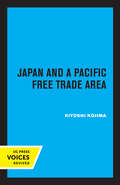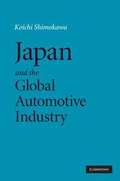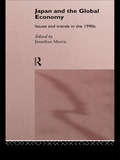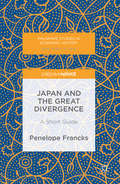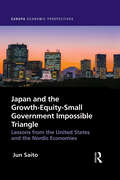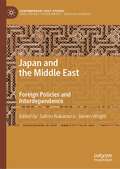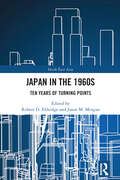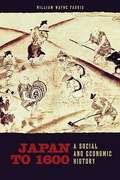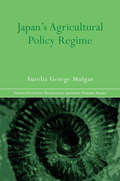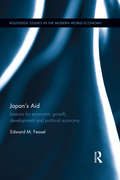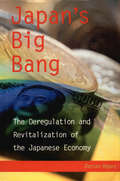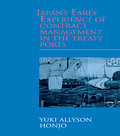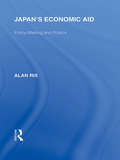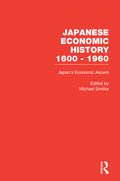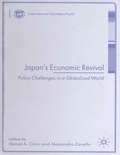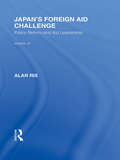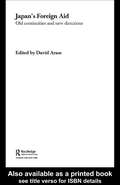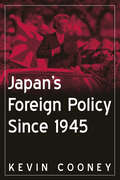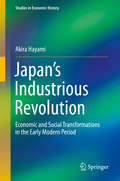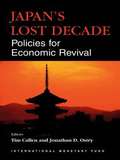- Table View
- List View
Japan and a Pacific Free Trade Area
by Kiyoshi KojimaThis title is part of UC Press's Voices Revived program, which commemorates University of California Press’s mission to seek out and cultivate the brightest minds and give them voice, reach, and impact. Drawing on a backlist dating to 1893, Voices Revived makes high-quality, peer-reviewed scholarship accessible once again using print-on-demand technology. This title was originally published in 1971.
Japan and the Global Automotive Industry
by Koichi Shimokawa"In this important book, Koichi Shimokawa presents new insights into the reasons for Japan's automotive industry success and describes crucial phases of its development. Looking ahead into the future of the industry, he makes a powerful argument for a turn towards ecological sustainability. A masterpiece by the doyen of Japan's academic automotive research community!"
Japan and the Global Economy: Issues and Trends in the 1990s
by Jonathan MorrisFirst published in 1991. Routledge is an imprint of Taylor & Francis, an informa company.
Japan and the Great Divergence
by Penelope FrancksThis text offers an accessible guide to the ways in which our growing knowledge of development in early-modern and modernising Japan can throw light on the paths that industrialisation was eventually to take across the globe. It has long been taken as read that the industrial revolution was the product of some form of 'European superiority' dating back to at least early-modern times. In The Great Divergence, Kenneth Pomeranz challenged this assumption on the basis of his evidence that parts of eighteenth-century China were as well placed as northern Europe to achieve sustained economic growth, thus igniting what has been called 'the single most important debate in recent global history'. Japan, as the only non-Western country to experience significant industrialisation before the Second World War, ought to provide crucial - and intriguing - evidence in the debate, but analysis of the Japanese case in such a context has remained limited. This work suggests ways of re-interpreting Japanese economic history in the light of the debate, so arguing that global historians and scholars of Japan have in fact much to say to each other within the comparative framework that the Great Divergence provides.
Japan and the Growth-Equity-Small Government Impossible Triangle: Lessons from the United States and the Nordic Economies (Europa Economic Perspectives)
by Jun SaitoThis volume examines and analyzes the current situation of, and the future prospects for, the Japanese economy, particularly in the context of inequality. The country's economy is facing the ageing and the shrinking of its population, both of which will reduce the potential growth rate, which has already become very low. By introducing a new policy framework, namely the `Equity-Growth-Small Government Impossible Triangle', based on reviewing, comparing and contrasting the policies of the United States, the Nordic economies and Japan, the book proposes a policy direction that could be pursued by Japan. If Japan wants to sustain growth while preventing inequality to widen and preserve an egalitarian society, there is no other choice but to further promote globalization and innovation and, at the same time, surrender preserving a small government by reforming itself to become a dynamic and resilient welfare state. The volume will be an invaluable resource for students, professionals and researchers with an interest in economics, inequality, the Japanese economy and comparative economic policies.
Japan and the Middle East: Foreign Policies and Interdependence (Contemporary Gulf Studies)
by Steven Wright Satoru NakamuraThe book provides a comprehensive analysis of the emergence, political economy and foreign relations of Japan’s relations with the Middle East, with an emphasis on its relations with the states in the Gulf Region. It offers both country specific case studies and thematic chapters, providing comprehensive study on Japan’s relations with the Gulf and the wider Middle East. Japan enjoys a strategic partnership with the Arab Gulf countries in terms of its energy trade, yet this has morphed into a wider trading relationship with the wider Middle East. The book studies Japan’s relations with Israel, Egypt and Turkey, covering security, the oil sector and the LNG sector Middle East. This will allow this book to go beyond its rich analytical and empirical content.
Japan and the Rise of China: Power Dynamics and Business Relations (Routledge Studies in International Business and the World Economy)
by Ferguson EvansThis book provides a comprehensive study of Japan’s evolving relationship with China since 1949, tracing the shifting dynamics from a distant relationship during the early communist era to a more cooperative phase in the late 20th century, and finally to the growing tensions of the 21st century.The book analyzes how Japan has responded to China’s rise from a third-world country to a global superpower, with particular attention to key themes such as economic relations, geopolitical tensions and strategic military developments. Drawing from Japanese- and Chinese-language sources, it offers an in-depth perspective on the mutual perceptions and responses shaping these two major East Asian powers. The book features a unique combination of historical analysis and contemporary thematic chapters that explore Japan’s strategic options as a middle power facing China’s growing influence. It provides readers with rare insights from non-Western sources, broadening the scope of understanding beyond typical English-language analysis. The book’s structure allows for a detailed exploration of both countries’ trajectories, making it a valuable resource for understanding the complex power shifts in East Asia.It is ideal for scholars, researchers and advanced students of international relations, East Asian studies, international business and global geopolitics. It also appeals to those interested in the broader implications of China’s rise and Japan’s role in the shifting global order.
Japan in the 1960s: Ten Years of Turning Points (Inside East Asia)
by Robert D. Eldridge Jason M. MorganEldridge and Morgan set a new paradigm for East Asian contemporary historiography by viewing the decade of the 1960s as hermeneutically powerful. From street battles over Japan’s security treaty with the United States, to a peace treaty with the former Japanese territory of South Korea, to Japan’s hosting the 1964 Summer Olympics, the 1960s in Japan was a decade of turning points. This book is the first to see the 1960s as a historical subject in its own right and argues that the specificity and internal complexity rooted in East Asia during this period showed how East Asians were dynamic agents in shaping the decade. In this volume, contributors consider Japanese responses to a 1961 coup in the Republic of Korea; the Satō Eisaku administration’s approach to nuclear deterrence and to the question of Okinawa’s return from American control; U.S.-Japan intellectual exchange during the Cold War; support by Japanese businesspeople for the Self-Defense Forces; the “soft power” of Japanese cinema in the 1960s; Japan’s understanding of 1960s United Nations peacekeeping operations; changes in “national polity” discourse in the 1960s; the Dalai Lama’s 1967 visit to Japan; economic development in and cultural exchange between 1960s Japan and Spain; Japan’s science and technology interactions with the United States; and the earliest known, and suspected, cases of North Korean abduction of Japanese citizens. Much of the information in this volume has never appeared in English before.This is an important volume for historians, political scientists, sociologists, and other scholars specializing in the twentieth century and those interested in cutting-edge history-writing about a transformative 10-year period in East Asia.
Japan to 1600: A Social and Economic History
by William Wayne Farris<p>Japan to 1600 surveys Japanese historical development from the first evidence of human habitation in the archipelago to the consolidation of political power under the Tokugawa shogunate at the beginning of the seventeenth century. It is unique among introductory texts for its focus on developments that impacted all social classes rather than the privileged and powerful few. In accessible language punctuated with lively and interesting examples, William Wayne Farris weaves together major economic and social themes. The book focuses on continuity and change in social and economic structures and experiences, but it by no means ignores the political and cultural. Most chapters begin with an outline of political developments, and cultural phenomena―particularly religious beliefs―are also taken into account. In addition, Japan to 1600 addresses the growing connectedness between residents of the archipelago and the rest of the world. <p>Farris describes how the early inhabitants of the islands moved from a forager mode of subsistence to a more predominantly agrarian base, supplemented by sophisticated industries and an advanced commercial economy. He reveals how the transition to farming took place over many centuries as people moved back and forth from settled agriculture to older forager-collector regimes in response to ecological, political, and personal factors. Economics influenced demographics, and, as the population expanded, the class structure became increasingly complex and occupational specialization and status divisions more intricate. Along with this came trends toward more tightly knit corporate organizations (village, city, market, family), and classes of servants, slaves, and outcastes formed. <p>In reflecting the diversity of traditional Japan’s economy and society, Japan to 1600 is well suited for both undergraduate and graduate courses and will be a welcome introduction to Japan’s early history for scholars and students of other disciplines and regions.</p>
Japan's Agricultural Policy Regime (Nissan Institute/Routledge Japanese Studies)
by Aurelia George MulganWritten by the world’s leading expert in the field, this book examines the evolution of Japanese agricultural policy in the post-war period, focusing particularly from the 1970s onwards when both domestic and external pressures for reform began to intensify. The author explains how the MAFF has safeguarded their institutional capacity to intervene by accommodating both public interest in agricultural policy reform alongside the interests of government in maintaining agricultural support and protection. The book provides a major reinterpretation of agricultural policy, examining how the MAFF’s role as an ‘intervention maximiser’ has been redefined in the face of continued bureaucratic involvement. Making available in English for the first time Japanese policy changes in the post-war period, the book will appeal to political economy specialists and political scientists, and those with an interest in Japanese politics and bureaucratic institutions.
Japan's Aid: Lessons for economic growth, development and political economy (Routledge Studies in the Modern World Economy)
by Edward M FeaselIn the twentieth century Japan emerged as one of the world’s leading economic powers: rising from wartime destruction to a leading economic engine in world markets. Japan’s economic aid policy, beginning with war reparations following its defeat in World War II, became a vehicle to help achieve this economic success. As the country continued to flourish, economic aid also became a means of expanding the country’s influence in an era of increasing globalization, providing an alternative strategy for helping developing nations escape the traps of poverty: a strategy drawn from its own experience of reemergence. And as we stand at the beginning of a new century, Japanese aid policy may also serve as a potential model for other nations who are on the cusp of entering high-income status and the group of elite world donors: a model that in many ways lies in contrast to policies espoused by other advanced Western nations. The book Japan’s Aid examines the strengths and weaknesses of Japanese aid policy in all of these dimensions: in fostering economic growth in both its own economic success story and in the numerous countries to which it has served as the single largest bilateral donor over many years; and as a policy that other nations might emulate. Through a combination of insightful case studies and rigorous econometric investigation, the book presents a comprehensive examination of the pros and cons of Japan’s aid.
Japan's Automakers Face Endaka
by Debora L. Spar Julia Kou Elizabeth B. SteinIn April 1995, the Japanese yen hit a post-World War II high against the U.S. dollar. The yen's relentless ascent affected firms on both sides of the Pacific, but fell particularly hard on Japan's big four automakers. This case explores how endaka--or"high yen"--changes the competitive environment for the automakers and how they respond to the change. Examines how macroeconomic and political shifts can dramatically affect the competitive position of firms operating in a global economy. Also describes how firms can reshape their strategies to compete even in starkly different domestic environments.
Japan's Big Bang
by Declan HayesJapan's national economy: understanding the history of the current crisis and proposing a path forwardThe consistent failure of the Japanese bureaucracy and business establishment to meet proper management and regulatory standards has made America's premier ally in Asia a major source of financial instability in today's world.Japan has the world's biggest everbad-debt burdenJapan has allowed organized crime to systematically infiltrate its financial institutionsJapan's national pension system faces imminent bankruptcyJapan's banks, brokerages, and insurance houses are near insolvency and welded to obsolete practices that hold the entire country and region backJapan's Big Bang traces the hurdles Japan must overcome to once again reign as one of the world's preeminent financial powerhouses. With an academic's analytical eye and the tenacity of a financial beat reporter, Declan Hayes explores the tangled mess that was and is Japan's economy, and explores the remedial action Japan must follow to regain and sustain its position as the economic engine of Asia.
Japan's Corporate Income Tax--Overview and Challenges
by Thomas DalsgaardA report from the International Monetary Fund.
Japan's Early Experience of Contract Management in the Treaty Ports
by Yuki Allyson HonjoThis is the first in-depth study of the early trial-and-error experiences of contracting between Japanese and western merchants trading in the Japanese Treaty Ports in the eighteen year period immediately following the opening of the ports in 1859. Fundamental to the equation were the inevitable east-west cultural and legal ambiguities that impacted on the traders. The learning curve for both westerners and Japanese regarding the nature and application of western contracting law was predictably difficult, tortuous and open to constant misunderstanding. Nevertheless, it was within such a framework that the principal benchmarks for trade with Japan were set down and which, in essence, have lasted to the present day.
Japan's Economic Aid: Policy Making and Politics (Routledge Library Editions: Japan)
by Alan RixJapan’s arrival since World War Two as a major industrial nation has meant that she has had to bear a greater share of the developed world’s contribution to the developing nations and foreign aid has become an integral part of foreign policy. This book describes the roots of Japan’s aid policy and shows that this side of her international economic policy is based largely on domestic conditions, structures and forces. To understand the pattern of Japanese aid as it stands today, it is important to appreciate the complexities of the Japanese decision-making process. This book clearly explains the patterns of Japanese aid policy-making.
Japan's Economic Ascent: International Trade, Growth, and Postwar Reconstruction (Japanese Economic History 1600-1960)
by Michael SmitkaMakes Japanese sources accessible in EnglishAlthough much of the work on Japanese economic history is inaccessible to Westerners, many of Japan's leading economic historians have published widely in English. Combined with the work of Western economists who can utilize Japanese-language sources, this series assembles a wide range of English-language articles on the key issues in Japanese economic development. Individual volumes cover the interwar period, postwar reconstruction and growth, the textile industry, demographics, agriculture, trade, and the rise of commerce and "protoindustry" in the Tokugawa era. Aninformation-packed classroom and research resource An introductory essay in each volume discusses the significance of the articles, compares various economic development in Japan with those in other countries, and puts studies in the context of similar studies in Europe. A versatile research resource, this 7-volume set is a veritable gold mine of hard-to-find information and data from diverse sources and a godsend to everyone interested in comparative economic and social history. Professors will appreciate the collection because it gives them instant access to less familiar English-language sources and is an easy way to introduce students to doing their own research. Students will appreciate the many articles as a mother lode of information for reports and papers. Researchers will be pleased by the coverage of more than three centuries of Japanese history and life.
Japan's Economic Planning and Mobilization in Wartime, 1930s-1940s
by Yoshiro MiwaAlthough most economists maintain a (justifiable) mistrust of a government's goals when it intervenes in an economy, many continue to trust its actual ability. They retain, in other words, a faith in state competence. For this faith, they adduce no evidence. Sharing little skepticism about the government ability, they continue to expect the best of governmental intervention. To study government competence in World War II Japan offers an intriguing laboratory. After all, governments direct wars. They decide whether to prepare for them, when to initiate them, how to execute them, and the terms on which to end them. Toward that end, the public sometimes grants them as much power as it can feasibly grant. And in Japan during World War II, the public granted the state the maximum power. In this book, Yoshiro Miwa shows that the Japanese government did not conduct requisite planning for the war by any means. It made its choices on an ad hoc basis, and the war itself quickly became a dead end. That the government planned for the war incompetently casts doubts on the accounts of Japanese government leadership more generally.
Japan's Economic Revival: Policy Challenges in a Globalized World
by Daniel A. Citrin Alessandro ZanelloThis book focuses on Japan's recent recovery from a decade-long stagnation, with particular attention to the unfinished policy agenda and the international spillovers of Japan's policies, through& background studies (both analytical and descriptive) by IMF economists.
Japan's Financial Revolution and How American Firms are Profiting
by Stephen M. HarnerThis book examines the rapid deregulation and changing nature of Japan's financial marketplace as it emerges from its worst economic crisis since the end of the Second World War. The author focuses on how U.S. firms like Citibank, AIG, Merrill Lynch, GE Capital, Fidelity Investments, and American Express have made large investments and built strategic businesses in a market that was effectively closed to them only a few years ago. He also profiles Japan's major financial institutions, which are aggressively restructuring to defend their home turf from foreign competitors.Now that the economic crisis appears to be over, this exciting new book gives business students, scholars, and executives an in-depth analysis and understanding of the on-going transformation of the Japanese marketplace in banking, securities, insurance, asset management, mutual funds, and consumer credit.
Japan's Foreign Aid Challenge (Routledge Library Editions: Japan)
by Alan RixWhen this volume was published in 1993 it was the first comprehensive analysis of the major policy issues confronting Japan’s massive foreign aid programme. It deals with the philosophy behind Japan’s aid, Japanese reactions to the severe criticisms of its programmes and the beginnings of meaningful administrative reform of the complex aid system. Alan Rix goes on to examine the widespread innovation in programmes and policies to make Japan’s aid more responsive and the impact of the Asian bias in Japan’s aid.
Japan's Foreign Aid: Old Continuities and New Directions (Routledge Contemporary Japan Series #Vol. 2)
by David AraseFilling a gap in the existing literature, this book analyzes the distinctive features of Japan’s development aid, especially technical co-operation, in comparison with other donors’ aid. Incorporating a wealth of research, it discusses whether Japan is behind other leading donor countries in rethinking its aid policy and whether it lacks transparency, sensitivity to recipient needs, and a coherent and coordinated policy that targets poverty. The volume assesses the nature and effectiveness of the administration of Japan’s aid, and explores the degree of involvement of private sector and non-governmental organizations (NGOs). Including contributions from experts with direct experience with Japanese ODA, the book provides a wide range of recipient and donor viewpoints and presents important policy recommendations.
Japan's Foreign Policy Since 1945
by Kevin J. CooneyThis student-friendly text provides a detailed and up-to-date assessment of Japan's foreign policy since 1945, including policy options and choices that Japan faces in the twenty-first century. Using information based on interviews with policymakers in Japan, the author provides new insight into Japan's foreign policy options and analyzes the nation's evolving role in international affairs. The book begins with a brief overview of major issues related to Japan's foreign policy since the mid-nineteenth century, and then focuses on the direction of Japanese foreign policy from 1945 to the present. It examines issues such as Article Nine of the Japanese Constitution, national security needs, the way Japan views the world around it, the role of nationalism in setting policy, and the influence of big industry. It also includes material on Japan's response to 9/11 and the war in Iraq. Designed for both undergraduate and graduate level courses, the text includes Discussion Questions, maps, a detailed bibliography with suggestions for further reading, and an Appendix with the Japanese Constitution for easy reference.
Japan's Industrious Revolution
by Akira HayamiThis book explains in fascinating detail how economic and social transformations in pre-1600 Japan led to an industrious revolution in the early modern period and how the fruits of the Industrious Revolution are what have supported Japan since the eighteenth century, improving living standards and leading to the formation of the work ethic of modern Japan. The arrival of the Sengoku Period in the sixteenth century saw the emergence and domination of government by the warrior class. It was Tokugawa Ieyasu who unified the realm. Yet this unity did not give rise to an autocratic state, as the shogun was recognized merely as a main pillar of the warrior class. Economically, however, from the fourteenth century, currency payments for shōen nengu (taxes paid to the proprietor) became standard, and currency circulation began, primarily in the central region. Under Tokugawa rule, organized domestic coinage of currency began, opening the way to establishing a national economic society. Also, agricultural land was surveyed through cadastral surveys known as kenchi. Land values were converted in terms of rice, so the expected rice yields for each village were assessed, and the lords used this as a benchmark for imposing taxes. In the sixteenth and seventeenth centuries, Japan experienced a "great transition," and conditions for peasants, agriculture, and farming villages underwent great changes. Inefficient traditional agriculture using peasants in a state of servitude was transformed into highly efficient small-sized farming operations which relied on family labor. As production yields increased due to labor-intensive agriculture, the profits obtained by the peasants improved their living standards. The stem-family system became the norm through which work ethics and even literacy were transmitted. This very change was the result of the "industrious revolution" in Japan. The book thus presents the framework of the facts of pre-industrial Japanese history and depicts pre-modern Japan from a macroscopic point of view, showing how the industrious revolution came about. It is certain to be of great interest to economists and historians alike.
Japan's Lost Decade
by Jonathan D. Ostry Tim CallenFor thirteen years excess capacity and debt have weighed down the Japanese economy. This weak economic performance has implications for the world economy as a whole and so the IMF has been involved in a dialogue with the Japanese authorities to identify the policies needed to bring it out of its slump. The papers in this book are part of the process of identifying the causes and proposing solutions. They examine the weakness of the financial sector; corporate restructuring and structural reforms; fiscal policy; monetary and exchange rate policy and the impact of Japanese economic policies on the rest of Asia. The overall conclusion is that although a start has been made on necessary reforms, much still needs to be done
